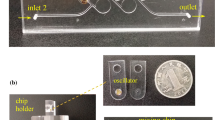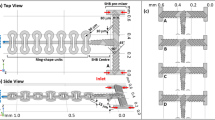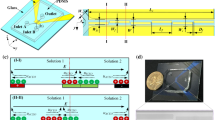Abstract
Mixing in micro-environment has been explored in a number of studies. This study presents a unique approach of efficient mixing of two heterogeneous streams via two counter-rotating recirculatory streams induced by in-plane resonance of a rectangular microplate actuated via Lorentz force. The generated time-mean flow structure was interrogated for mixing efficacy over a range of excitation voltage, Reynolds number, and Pèclet number, along with numerical analysis to probe the time-mean flow physics. Results show that the recirculatory flow is generated at the plate’s edges due to local flow non-linearity, characteristic of acoustic streaming. The percentage of mixing, at one device length-scale downstream, attains 93% at a low Reynolds number of 0.0037 (based on mean velocity of 0.078 mm/s and channel height of 50 μm) at 8 V excitation. Further characterization via enhanced diffusivity shows a maximum of 80.7-fold increase. Comparison with other active mixers shows the current device achieves mixing in one of the shortest distances. The proposed approach is robust, tunable to attain desired mixing characteristics and essentially independent of the properties of the fluid medium, which should be useful in a number of microfluidic applications requiring fast mixing.









Similar content being viewed by others
References
Ahmed D, Mao XL, Shi JJ, Juluri BK, Huang TJ (2009a) A millisecond micromixer via single-bubble-based acoustic streaming. Lab Chip 9(18):2738–2741
Ahmed D, Mao XL, Juluri BK, Huang TJ (2009b) A fast microfluidic mixer based on acoustically driven sidewall-trapped microbubbles. Microfluid Nanofluid 7(5):727–731
Bengtsson M, Laurell T (2004) Ultrasonic agitation in microchannels. Anal Bioanal Chem 378(7):1716–1721
Bothe D, Sternich C, Warnecke HJ (2006) Fluid mixing in a T-shaped micro-mixer. Chem Eng Sci 61(9):2950–2958
Bottausci F, Cardonne C, Meinhart C, Mezic I (2007) An ultrashort mixing length micromixer: the shear superposition micromixer. Lab Chip 7(3):396–398
Bowman JA, Schwartz DT (1998) High Peclet number mass transfer in the acoustic streaming flow between two concentric cylinders. Int J Heat Mass Transf 41(8–9):1065–1074
Chun H, Kim HC, Chung TD (2008) Ultrafast active mixer using polyelectrolytic ion extractor. Lab Chip 8(5):764–771
Dyke MV (1982) An album of fluid motion. The parabolic press, California
Einstein A (1956) Investigations on the theory of the Brownian movement. Dover Publications, New York
Hessel V, Lowe H, Schonfeld F (2005) Micromixers—a review on passive and active mixing principles. Chem Eng Sci 60(8–9):2479–2501
Holtsmark J, Johnsen I, Sikkeland T, Skavlem S (1954) Boundary layer flow near a cylindrical obstacle in an oscillating, incompressible fluid. J Acoust Soc Am 26(1):26–39
Howell PB, Mott DR, Golden JP, Ligler FS (2004) Design and evaluation of a Dean vortex-based micromixer. Lab Chip 4(6):663–669
Hsiung SK, Lee CH, Lin JL, Lee GB (2007) Active micro-mixers utilizing moving wall structures activated pneumatically by buried side chambers. J Micromech Microeng 17(1):129–138
Hsu CH, Folch A (2006) Spatio-temporally-complex concentration profiles using a tunable chaotic micromixer. Appl Phys Lett 89(14):3
Johnson TJ, Ross D, Locascio LE (2002) Rapid microfluidic mixing. Anal Chem 74(1):45–51
Landau LD, Lifshitz EM (1958) Fluid mechanics. Pergamon Press, London
Leighton TG (1994) The acoustic bubble. Academic Press, London
Lin CM, Lai YS, Liu HP, Wo AM (2008a) Microvortices and recirculating flow generated by an oscillatory microplate for microfluidic applications. Appl Phys Lett 93(13):133503
Lin CM, Lai YS, Liu HP, Chen CY, Wo AM (2008b) Trapping of bioparticles via microvortices in a microfluidic device for bioassay applications. Anal Chem 80(23):8937–8945
Liu RH et al (2000) Passive mixing in a three-dimensional serpentine microchannel. J Microelectromech Syst 9(2):190–197
Liu RH, Yang JN, Pindera MZ, Athavale M, Grodzinski P (2002) Bubble-induced acoustic micromixing. Lab Chip 2(3):151–157
Lu LH, Ryu KS, Liu C (2002) A magnetic microstirrer and array for microfluidic mixing. J Microelectromech Syst 11(5):462–469
Lutz BR, Chen J, Schwartz DT (2005) Microscopic steady streaming eddies created around short cylinders in a channel: flow visualization and Stokes layer scaling. Phys Fluids 17(2):023601
Marmottant P, Hilgenfeldt S (2003) Controlled vesicle deformation and lysis by single oscillating bubbles. Nature 423(6936):153–156
Nguyen NT, Wu ZG (2005) Micromixers—a review. J Micromech Microeng 15(2):R1–R16
Sasaki N, Kitamori T, Kim HB (2006) AC electroosmotic micromixer for chemical processing in a microchannel. Lab Chip 6(4):550–554
Schlichting KGH (1979) Boundary-layer theory. McGraw Hill, New York
Stroock AD et al (2002) Chaotic mixer for microchannels. Science 295(5555):647–651
Sudarsan AP, Ugaz VM (2006) Multivortex micromixing. Proc Natl Acad Sci USA 103(19):7228–7233
Tung KY, Yang JT (2008) Analysis of a chaotic micromixer by novel methods of particle tracking and FRET. Microfluid Nanofluid 5(6):749–759
Wang SS, Jiao ZJ, Huang XY, Yang C, Nguyen NT (2009) Acoustically induced bubbles in a microfluidic channel for mixing enhancement. Microfluid Nanofluid 6(6):847–852
Xia YN, Whitesides GM (1998) Soft lithography. Annu Rev Mater Sci 28:153–184
Yang Z, Goto H, Matsumoto M, Maeda R (2000) Active micromixer for microfluidic systems using lead-zirconate-titanate(PZT)-generated ultrasonic vibration. Electrophoresis 21(1):116–119
Yang Z, Matsumoto S, Goto H, Matsumoto M, Maeda R (2001) Ultrasonic micromixer for microfluidic systems. Sens Actuators A Phys 93(3):266–272
Acknowledgments
Funding from AOARD (grant 094118) is gratefully acknowledged. Partial support for CM Lin is provided by the National Science Council (NSC 99-2120-M-582 002-004).
Author information
Authors and Affiliations
Corresponding author
Rights and permissions
About this article
Cite this article
Lin, CM., Liu, HP., Lai, YS. et al. Micromixing via recirculatory flow generated by an oscillatory microplate. Microfluid Nanofluid 11, 167–176 (2011). https://doi.org/10.1007/s10404-011-0783-8
Received:
Accepted:
Published:
Issue Date:
DOI: https://doi.org/10.1007/s10404-011-0783-8




